
A practitioner-driven agenda provides a unique lens for addressing challenges facing community economic development. The People and Places conference represented a joint effort by four organizations: NACEDA (the National Alliance of Community Economic Development Associations), NALCAB (the National Association for Latino Community Asset Builders), National CAPACD (the National Coalition for Asian Pacific American Community Development), and the National Urban League.
Our use of the word “congress” in the title recalls a past group known as NCCED or the National Congress for Community Economic Development, the leading trade association for CDCs (community development corporations) from the 1970s until the early 2000s. NCCED gatherings regularly attracted hundreds of practitioners. In 1998, Shelterforce profiled NCCED in its one-hundredth issue. The article noted that, “With more than 700 member organizations and a budget of close to $3 million, NCCED serves CDCs by providing information, technical assistance, and policy support, and by offering a wide range of networking opportunities through which local organizations can develop ways to support each other.” Yet even as NCCED’s budget tripled during the 1990s, as Dee Walsh and Robert Zdenek would later point out, different forces–notably NCCED’s failure to fully welcome Latino and Asian groups, mission creep, and the growth of state associations–all helped reduce membership and ultimately led to its demise.
NCCED’s last major national gathering occurred in Los Angeles in 2004, although the group sputtered on for two more years, publishing a list of policy recommendations and a census of the CDC field before closing its doors in 2006. The Democracy Collaborative was present at NCCED’s last public policy forum, held in March of that year. Although we tried to put the best light on it at the time (if you read our recap, you’ll notice that we conveniently failed to identify the number of attendees), NCCED’s final public event felt more like a wake than a conference.
As Harold Simon pointed out at the time, “Change can be good or bad” and there has been plenty of both in the past decade. This year’s People & Places conference—which brought some of the components of the old NCCED back together, albeit in a very different way—may help us think about where community development could be headed today.
Last year, in Shelterforce, one of us (Gar Alperovitz) wrote specifically about the need for a transformative vision for the field and suggested that building economic power through community wealth building and community ownership could help us to begin to address the obvious, systemic failures of our current system, such as the fact that “virtually all the gains of the entire economic system have gone to a tiny, tiny group at the top for at least three decades.” The themes touched on by the People & Places conference suggest that we are far from alone in this view. Panels were organized in four major thematic areas—community control, capital flow, neighborhood-level economies and thriving people.
It is also worth noting the themes that were not listed—such as housing and (despite taking place in Washington, D.C.) federal policy, two traditional focus areas. Of course, there were panels on housing and federal policy, but the overarching themes spoke to an important change in emphasis. As a result, this was an event where our work with Native communities, the challenges of multi-racial organizing, St. Louis-area efforts at transit-oriented development, and discussion of cooperative development in Minneapolis fit in easily alongside traditional CDC topics such as housing and federal policy.
In the above-mentioned article about building a transformative vision, one recommendation was “to build upon existing precedents in the ownership of land and worker-owned enterprises to promote locally anchored jobs and investment.” This need for community control was a common refrain at the conference. John Flory, who helped develop Minneapolis’ cooperatively owned Mercado Central, noted that, “To control the future of the business district, you need to own the buildings.” Frank Woodruff, executive director of NACEDA, perhaps summed up the challenge best: “Our field has focused a lot on transactions, not enough on transformation.”
While the proof will be in the follow-up, the People & Places conference may mark an important milestone in making this shift.
(Image credit: the National Alliance of Community Economic Development Associations)





Comments